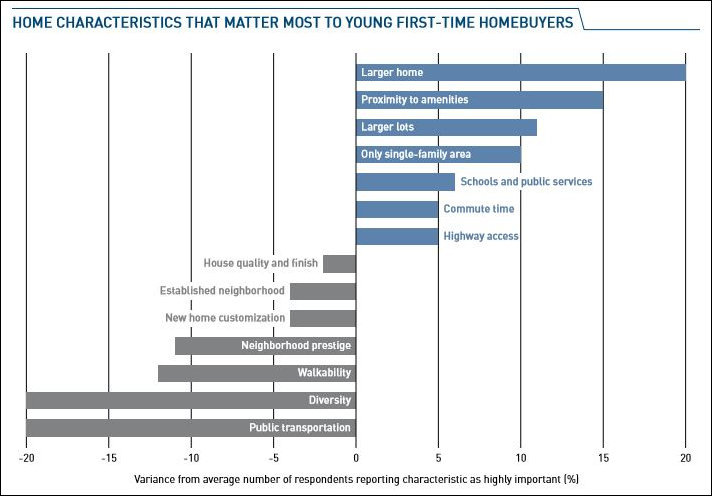
Source: “Housing in the Evolving American Suburb.” Home buyers still show strongest preference for housing attributes associated with suburban living.
For all the talk of urban renaissance in cities across Virginia and the United States, first-time home buyers find that new or existing suburban homes offer the best match for their preferences and budget, reports the Urban Land Institute (ULI) in a new study, “Housing in the Evolving American Suburb.”
While American’s urban cores are experiencing investment and population growth after decades of disinvestment and flight, the action is still in the suburbs because that’s where most of the developed land is. And, while members of the Millennial generation may value walkability and access to public transit more than previous generations, they still put the highest value on square footage, larger lots, and access to good schools and public services.
Nevertheless, there is likely a deficit of walkable urbanism compared to the demand for it, and that scarcity creates a premium for houses in walkable neighborhoods, the study argues.
In the coming years, efforts will likely continue to make at least some suburban areas more urban, with walkability to restaurants, stores, and other conveniences, combined where possible with access to good transit. Some of that development will be close to existing urban areas, and some will be close to existing or newly built mixed-use modes that include restaurants and stores. Some of the suburban development will deliver a more urban experience for a wider range of households. … Many large master-planned communities are including urban town centers as a component of their development.
Bacon’s bottom line: So, the race is on in metropolitan regions like Richmond. Who can move faster to attract affluent households that pay the most in taxes and enjoy the greatest ability to live where they want — the City of Richmond or the suburban counties? The city has the walkable neighborhoods, proximity to cultural amenities, and access to mass transit. But the counties have larger lots and houses, lower taxes, and access to better public schools.
Both cities and counties in Virginia have the potential to offer the best of both worlds. The City of Richmond could gain an enormous competitive advantage if it could improve the quality of its public schools. Sadly, that seems to be an intractable task. Conversely, Henrico and Chesterfield Counties could gain a competitive advantage by zoning for walkable, mixed-use neighborhoods. Although the counties have allowed islands of walkable urbanism to take root, the pace of change is glacially slow.
Both urban and suburban jurisdictions face institutional rigidities that prevent them from achieving maximum potential in the early 21st century. What a shame.


